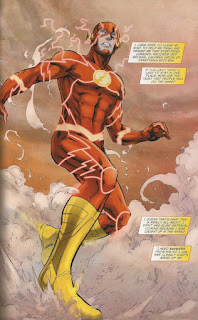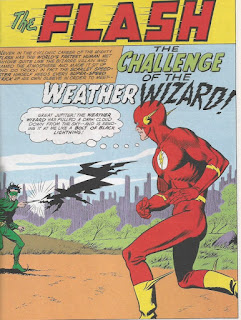Pick of the Brown Bag
January 19, 2021
by
Ray Tate
Hey, gang. It's Ray Tate with a triple dose of reviews from the Pick of the Brown Bag. This week, I examine another handful of DC's Future State titles: Dark Detective, the Flash and Kara Zor-El Superwoman. Should you not have the time for the full critiques, look me up on Twitter: #PickoftheBrownBag.
Don't buy The Flash. Writer Brandon Vietti recycles Flash plots of yore to present a crossbreed of dark, dull and dim.
The story opens with Checkmate and their annoying chess lingo.
Using Rogue's Gallery weapons, the Flashes infiltrate Checkmate's stronghold. That's two, count 'em two, old Flash plots in one: powerless Flash and Flash wielding Rogue's Gallery weaponry.
In case you still don't know what's going on, artist Dale Eaglesham telegraphs the loss of superpowers with a silly bandage on Avery, the grape Flash, and a grunge-look knee-hole in the Flash uniform for a beefed up Barry Allen.
The New 52 Flash debuted as this svelte runner.
That gibes with the Silver Age Scarlet Speedster.
The original television Flash, John Wesley Shipp, wore a sculpted bodysuit designed by Dr. Tina McGee meant to protect him from the physics of speed.
That doesn't appear what we have here. If the Flash Family lack powers, why sport a costume at all? Why not don, lighter, red body armor like a powerless Wally West did in the Elseworld series JLA Act of God.
Martian Manhunter, The Flash, Aquaman, Supergirl and of course Batman
This bulky Flash of Future State just looks silly, and of course angry. Because it's the Future State, and in the future everybody but the new Wonder Woman is angry.
Grrrr!
Of course, when it comes to inane design, little can top The Thinker's dynamite shower cap.
That's not the Thinker. New or old. It's the Calculator. The reveal exemplifies the kinda surprise. A surprise that's yes, in essence unexpected but empty of impact.
Like, if you see a bunch of Joker-piranha in the Gotham reservoir, you would naturally think the Joker behind the scheme, only to discover the Penguin is the culprit.
It must be casual Friday at Checkmate, because the Calculator used to look like this guy.
That's nowhere near as bad as the shower cap. Hey, but don't underestimate the Calculator. Yes, he's now one of many in the legion of loonies with buckets on their heads, but he can still use his trusty Texas Instruments pocket calculator to do stuff like this.
Nooooooo! He killed Bart! I can't believe he killed Bart, somehow.
This is the typical moment you get in The Flash. Attempts to escalate drama with death, that doesn't count anyway, and no explanation as to what happened.
Bart employed the Rainbow Raider's gear. The Rainbow Raider is a lackluster Flash villain from the eighties. His rainbows are multi-colored force fields. How can Calculator's destruct ray turn a force field into shrapnel? Why didn't the ray bounce off the force field? Why not just shoot the kid? So many questions. Ah, well. Bart's dead. Let's move along shall we.
Oh, that takes cheek.
After whittling down the Flash family, Vietti reveals Wally West is a murdering psychopath. A speed vampire, if you will.
Nooooo! Not Black Wally West! Ohhhhhhh, the tragedy!
Keiynan Lonsdale portrays the only Wally West on CW's The Flash.
Lonsdale and the CW writers turned this version of Wally West into somebody impressive, completing his growth on, where else, Legends of Tomorrow.
Of course Black Wally West's death doesn't mean beans either because we're in the The Future State. However, killing Flashes is another recycled Flash plot combined with the old Flash turns killer or Flash wanted for murder.
In an attempt to connect with Wally West's mind in the Speed Force, Barry rejiggers the Thinker's cap to reflect something more elegant. Behold.
Thank goodness, we focused on science. Once the team track down Wally, we learn about recycled Flash plot number six: I didn't do it. I'm possessed.
Brandon Vietti commits a cardinal sin here. He spells Apokolips Apocalypse. Vietti clearly hasn't spent enough time in the DC editorial office. I kid, of course. This Rider isn't the Black Racer from Apokolips, which would make a wee bit of sense. It's the Rider of the Apocalypse. Famine. There's that kinda surprise again. The biblical dude is behind this whole thing. Famine, one of the Four Horsemen of the Apocalypse. Because, stuff. Sounds to me like we need the Seventh Son of a Seventh Son.
Mariko Tamaki skirted the edges of the Batman titles with a short story in the massive anthology Detective Comics 1027. This little fella served as a prelude to the Joker War, which I didn't care about and never read.
In the prologue, Tamaki introduces Nakano a disgruntled GCPD officer who blames Batman for the death of his partner and the loss of an eye. Nakano, a budding detective, misses the Joker's rather overt culpability. DC appears to have liked Tamaki's take on Batman. So much so, that they gave her stewardship over the Dark Knight in Dark Detective.
Dark Detective is somewhat similar to The Flash. The differences lie in the quality of writing and illustration. Mariko Tamaki presents a compelling first person narrative in Batman's voice. Dan Mora and Jordie Bellaire construct a Gotham City that appears to be evolving into the Gotham of Batman Beyond. Yet, it seems off kilter.
Certainly the people seem to like it. Gothamites are out and about, without fearing the dark. Indeed, the bright and cheery technology damns the darkness of former Gotham.
Batman of course hates it. Not just because of the overabundance of light. Though that doesn't help. He hates the state of Gotham because somebody called the Magistrate perverted his dream.
Batman and his alter-ego Bruce Wayne have for eighty odd years attempted to do one thing. As Batman, Bruce attacks crime head-on. As Bruce Wayne, Batman uses his philanthropic resources to better a society that breeds crime. Batman is utterly selfless. He hasn't used a single penny of his wealth for himself. Batman seeks to heal Gotham City.
The Magistrate sterilized Gotham City. Turned it into a police state and sent his possibly robotic Peacekeepers in to slaughter the heroes that protected Gotham in the past.
Ah-hah. Mayor Nakano. Remember that disgruntled police officer I spoke about. This is how Tamaki's character comes into play. Nakano wins the mayoral race in Detective Comics. As Mayor, he made the deal with the devil. Batman of course suffers because of it.
At the onset, Batman was an outlaw, from 1939 to 1941. In the seventies, some politico wanted to ban Batman. In the eighties, Rupert Thorne intended to prohibit Batman. In Batman: the Animated Series, incoming District Attorney Janet Van Dorn saw no difference in Batman and the criminals he puts behind bars.
Batman in the future is also hardly breaking any ground. As early as 1941, Batman descendent Brane a portmanteau of Bruce Wayne assumed the guise of Batman and fought alien overlords. Batman found himself whisked to the future in The Brave and the Bold where he allied with the Legion of Super-Heroes. Artist/writer Paul Pope in 2014 transported Batman to dystopian future Gotham City for the superb Batman: Year One-Hundred.
In many ways Dark Detective is the same old-same old Batman is a renegade theme. Tamaki's careful execution though gives these cliches their worth. Dan Mora's depiction of Bruce Wayne's haunting future shock convey what's at stake. Batman sees the flaws in this Utopia. The light doesn't envelop the entirety of the city. It still needs Batman.
The Magistrate and his Peacekeepers feel differently. We first see them hunting and wounding Bruce Wayne. The Magistrate appears to know Batman and Bruce Wayne are one in the same, but to protect their fiefdom, they keep his identity secret. Batman is dead. Bruce Wayne is dead. Two entities. One a beloved benefactor. The other a hated vigilante. Begs the question why does Gotham City buy such rot? No matter, if Gotham ever learned the secret of Bruce Wayne, they might start questioning the Magistrate's methods of eradication. The Magistrate cannot afford questions, for that reason, the hiding of the truth, Batman remains a tantamount threat.
The second story strangely enough involves Cole Cash, the Grifter. The Grifter briefly met Batman in JLA Wildcats, but for the life of me I have no idea why he's in Gotham City. Until his creator Jim Lee made it so, the Grifter hadn't even been part of the DCU. For those not in the know, Image under the banner Top Cow first published oodles and oodles of Wildcats.
No matter, Matthew Rosenberg's story, fueled by Carmine Di Giandomencio's kinetics, is a ton of fun.
Still, there's little reason why this tale couldn't have centered on Jason Todd, the Red Hood. The Red Hood would have attracted the same kind of clientele and made the same type of ruckus. He and Grifter operate in similar fashion. Red Hood however is associated with Batman and belongs to Gotham City.
If you buy one Future State book this week, spring for Superwoman. Both Dark Detective and Superwoman feature accomplished artwork, but Margueritte Bennett's story draws upon a greater depth of ideas. If you want to get mercenary about it. Dark Detective is six bucks. Superwoman four.
Bennet's tale begins with Krypto. Never actually seen in Superwoman he nonetheless makes a greater than average impact with his absence.
Before Jor-El sent his son to earth, he tested a smaller rocket with the family pet, a dog named Krypto. This is a lot less meaner than it sounds. Trust me on that. Things go wrong. Krypto becomes lost in space until the rocket comes crashing down to earth. Superman finds Krypto, and the doggy gains all the powers of his master Kal-El. Krypto is also smarter than an earth canine.
In 2019, writer Marc Andreyko created a memorable run of Supergirl where she set out to avenge Krypton. Apparently, Krypton didn't just explode. Superman accepts her decision but refuses to lose his only cousin to dark emotions. He gifts her Krypto.
Together, Kara and Krypto become partners in bringing justice and peace to all sentient kind. She gets revenge, but she doesn't lose herself in the process.
In the future Krypto dies. Of course, this death means nothing in the context of the actual DCU. Rest assured. Krypto is alive and well.
I Have This Hilarious Scene by Amanda Conner on a Tee-Shirt
Krypto's future death, for lack of a better phrase, actually weighs heavily in the story. Superwoman visits the grave and reveals her deep love for Krypto in her first person narration. The revelation, her love for Krypto sets the tone for the entire book.
The death of Krypto could have symbolized the utter nihilism of Future State. That's neither Marguerittes Bennett's and Savauge's game. They instead use Krypto and Kara's love for her dog to deliver a timely feminist message.
In conjunction they raise another point of contention I had with last week's Superman in Metropolis. Something I couldn't work into the previous review. Superman should have entrusted the earth's care to Supergirl as he intended in comics and as he did in CW's Supergirl.
In 1959, the original Supergirl arrived on earth at age fifteen, guesstimate. I doubt she could be any older than that. She saw Superman as her elder and her only family. She therefore acquiesced to his want to keep her existence hidden. You can argue that Superman was being chauvinistic, but the reality of it is that the writers wanted the character Supergirl to stand on her own two feet and gain a readership independent of Superman's fans. This is the best idea they could come up with at the time, and it wasn't a horrible one.
In the New 52 Supergirl arrives as a teenager unimpressed by earth, what with its armed forces immediately attacking her. As with her most recent television tweaks, Supergirl often babysat Kal-El on Krypton, but she finds Superman needs no sitting. In a proper example of the Twin Paradox, baby Kal-El grew up to be Superman while time seemed suspended for Kara.
Though reluctant at first, Kara began caring about innocent lives. She wasn't as noble as she was in the previous cosmos, but in a way her growth was more realistic.
From, I'm not earth's defender. They hate me. To, I suppose some humans aren't that bad. I don't really want to see anybody hurt, and I have the power to protect. So that's what I'll do. To hell with anybody that wants to stop me.
All of these factors come into play when delving into Kara Zor-El's backstory for the Future State. At some point, Supergirl and Johnathan Kent came to blows over being the protector of the earth, and why not?
She's even the proper product of the Twin Paradox. She worked hard to come to the realization that she is a superhero. The brat though gets the planet handed to him. Supergirl, angry and ashamed of her behavior turned to the Moon Colony which houses refugees of all ilk.
The problem is that Supergirl appears to be facing the same distrust, even from aliens.
We discover in Marc Andreyko's series that Kryptonians are not and never have been well liked as a species. That disdain contributed to their planet's demise. It's complicated and somehow involves a cosmic contract killer with an axe. I prefer the classic idea proposed by Dr. James Kakalios. Krypton was unstable due to forming around a neutron star and reached a natural death, sans Axe-Guy, but whatever.
The dislike for Kryptonians carries over, and this is where we encounter Kara's suppressed resentment for being treated so shabbily: by her cousin, his jackass son and the people she begrudgingly swore to protect. She even creates the fiction that Krypto taught her lessons about a complex philosophy of submission. When in fact...
Lynari is correct. In the Bronze Age, writers occasionally identified Krypto's thoughts to the readers, but never did Krypto actually talk to humans or Kryptonians in comics. Krypto is smart as a whip. Smarter than some humans, including Hal Jordan, but he never could convey the kind of life lessons Kara appeared to learn. Kara inferred the submissive lifestyle, perhaps symbolized by the long skirt made from her cape, from Krypto's naturally loyal behavior. Kara became a loyal dog.
Kara's entire life falls under scrutiny when Lynari an escapee from a dreadful planet crashes on the moon.
After a brief set-to against Lynari where she displays a vast array of power, Kara becomes her mentor and friend. However, the lessons she teaches are flawed because they derive from that same mind set that Kara constructed from her loneliness.
Superwoman is a satisfying deep dive. It's not however staid nor without humor.



































No comments:
Post a Comment